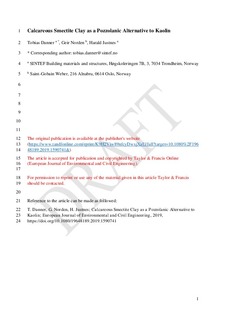| dc.contributor.author | Danner, Tobias | |
| dc.contributor.author | Norden, Geir | |
| dc.contributor.author | Justnes, Harald | |
| dc.date.accessioned | 2019-04-08T07:48:34Z | |
| dc.date.available | 2019-04-08T07:48:34Z | |
| dc.date.created | 2019-04-05T13:18:19Z | |
| dc.date.issued | 2019 | |
| dc.identifier.issn | 1964-8189 | |
| dc.identifier.uri | http://hdl.handle.net/11250/2593617 | |
| dc.description.abstract | The hydration of cement pastes with addition of a kaolinite rich clay (Clay A) and a calcareous smectite rich clay (Clay B) was investigated with isothermal calorimetry, in-situ XRD, PXRD, TGA and EPMA. Portland cement was replaced by 20, 35 and 50 weight% calcined clay in cement pastes and mortars. Both clays showed good pozzolanic reactivity. However, clay A having a higher amount of metakaolin and higher specific surface was more reactive in terms of CH consumption and mortar strength development. 50% replacement of PC by calcined Clay A resulted in increased 28 day compressive strength while mortars with 50% calcined Clay B showed almost equal 28 day compressive strength compared to the reference. With increasing addition of calcined clay, the second aluminate reaction (formation of AFm phase) of cement hydration was accelerated and the cement pastes became under sulphated. This resulted in a stronger and earlier sulphate depletion peak, especially in pastes with calcined Clay A. Due to 3% calcite in the used cement the main hydration product found was carboaluminate hydrate. The favoured formation of carboaluminate hydrate stabilised ettringite in the cement pastes. | nb_NO |
| dc.language.iso | eng | nb_NO |
| dc.publisher | Taylor & Francis | nb_NO |
| dc.title | Calcareous smectite clay as a pozzolanic alternative to kaolin | nb_NO |
| dc.type | Journal article | nb_NO |
| dc.type | Peer reviewed | nb_NO |
| dc.description.version | acceptedVersion | nb_NO |
| dc.source.journal | European Journal of Environmental and Civil Engineering | nb_NO |
| dc.identifier.doi | 10.1080/19648189.2019.1590741 | |
| dc.identifier.cristin | 1690439 | |
| dc.description.localcode | Locked until 5 April 2020 due to copyright restrictions. This is an Accepted Manuscript of an article published by Taylor & Francis in European Journal of Environmental and Civil Engineering on 5 April 2019, available at https://doi.org/10.1080/19648189.2019.1590741 | nb_NO |
| cristin.unitcode | 194,66,35,0 | |
| cristin.unitname | Institutt for materialteknologi | |
| cristin.ispublished | true | |
| cristin.fulltext | postprint | |
| cristin.qualitycode | 1 | |
